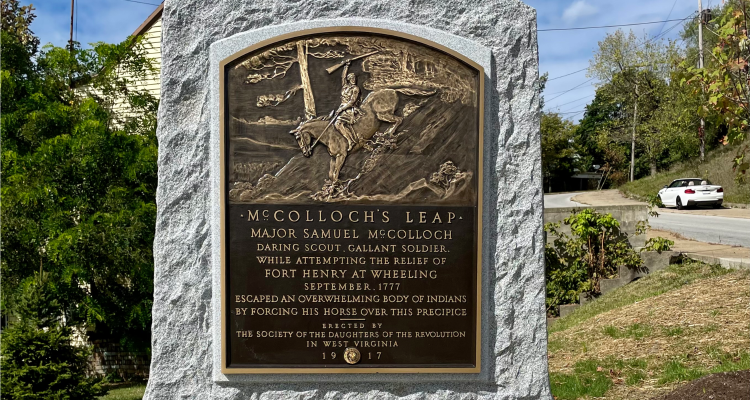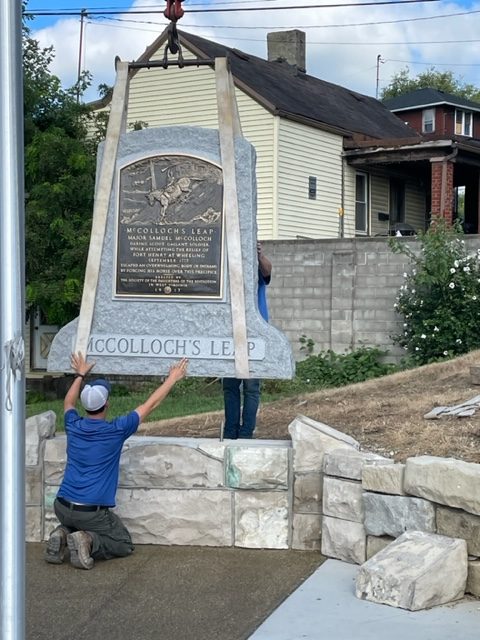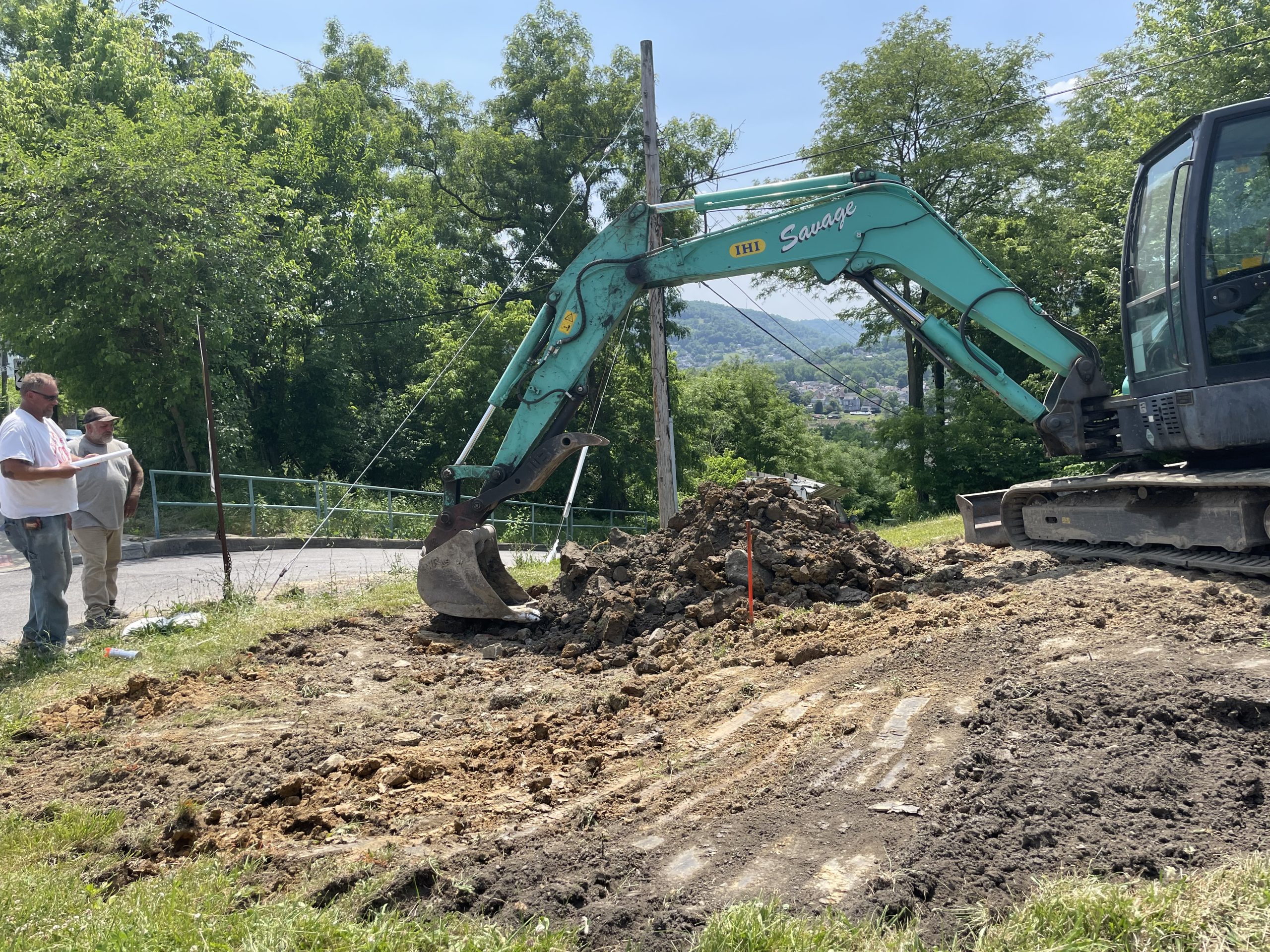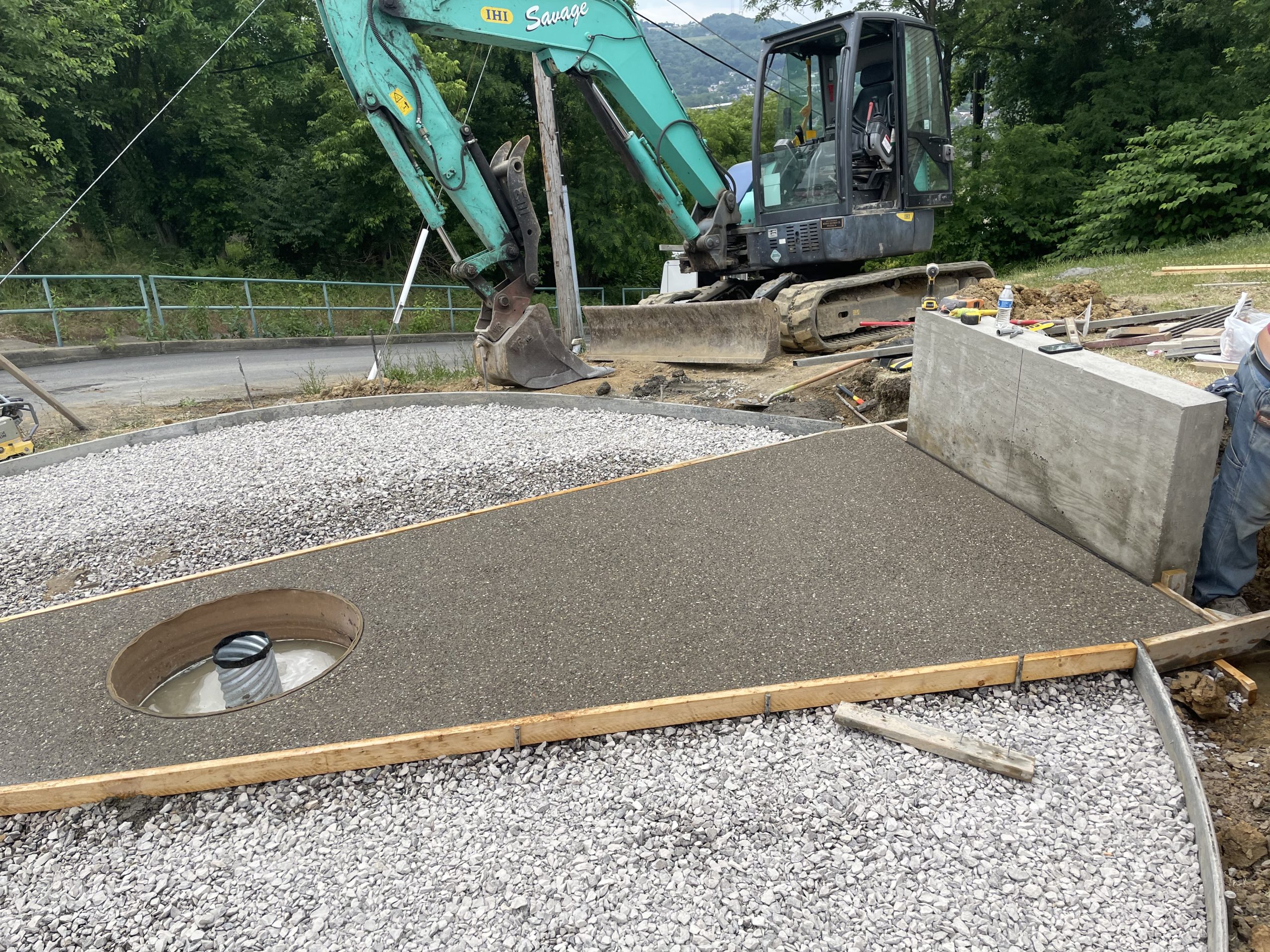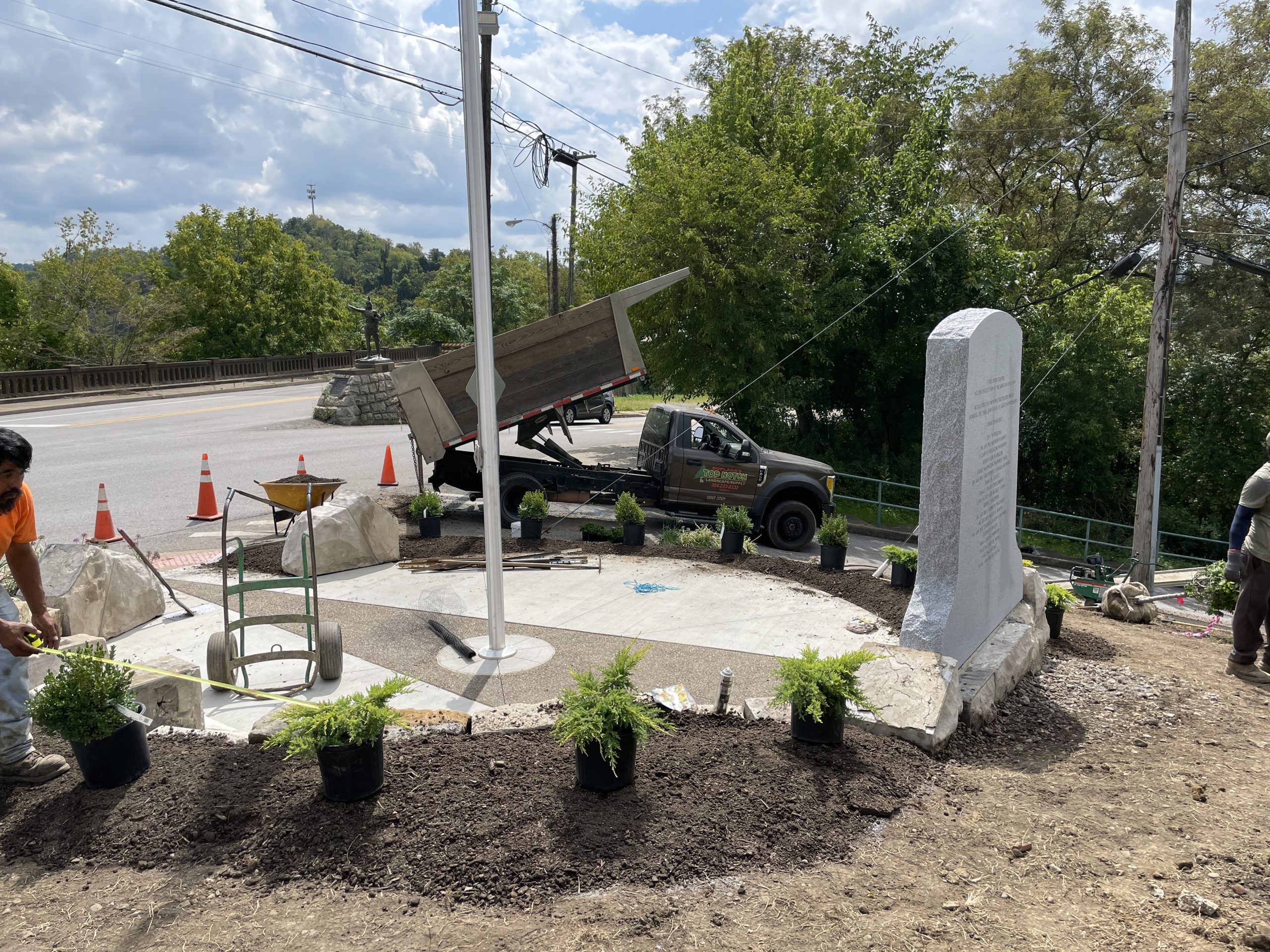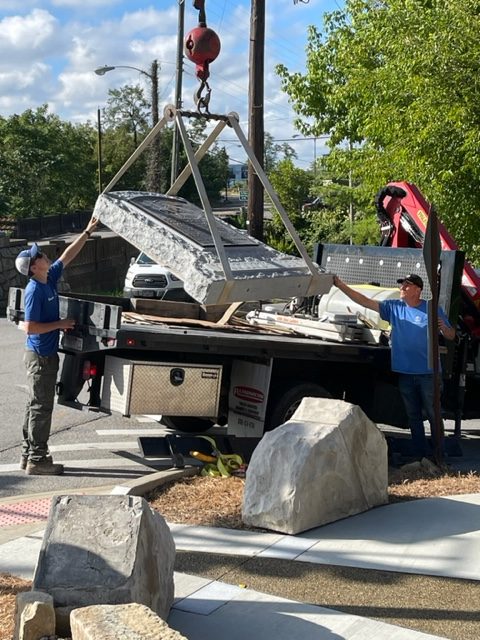Major Samuel McColloch’s “leap” stands as one of the most famous acts of pioneer heroism in the Upper Ohio Valley. On October 28, 2023, a brief dedication ceremony commemorated the completed relocation and restoration of the monument honoring McColloch’s daring escape down the east side of Wheeling Hill during the 1777 siege of Fort Henry.
The ceremony was the culmination of three years of planning and fundraising by Wheeling’s Fort Henry Chapter of the National Society, Sons of the American Revolution. The ribbon was cut by chapter member Robert A. McColloch, great-great-great-great nephew of Major McColloch. The monument initiative is the chapter’s signature project to mark the forthcoming 250th anniversary of American independence in 2026.
The First Siege of Fort Henry
In September 1777 a warrior force of about 200 Wyandot and Mingo, along with Shawnee and Delaware, launched a surprise attack on Fort Henry under the leadership of the Wyandot chief Dunquat, also known as Half King, who were allied with the British during the Revolutionary War.
Four men left Fort Henry to reconnoiter early that morning and were ambushed, one of whom was slain. The other three escaped, including two who returned to the Fort to raise the alarm for reinforcements. Militia from Fort Shepherd in Elm Grove and Fort Holliday in Weirton rushed to join the defenders.
The Famous Leap
Major Samuel McColloch answered the call, leading a small militia force traveling eight miles on horseback from Van Metre’s Fort at Short Creek. McColloch was separated from his men at the besieged fort’s gate and was pursued by the attackers. He charged up Wheeling Hill on horseback only to encounter a second war party approaching him from the opposite direction, and made what is known as “McColloch’s Leap“, spurring his horse 150 feet down its steep eastern hillside to the creek bed below. The warriors expected to see the major lying injured or dead at the bottom of the hill. To their great surprise McColloch was still mounted on his white horse, galloping away from them. He reached the safety of Van Metre’s Fort unharmed.
The war party remained overnight outside the fort, dancing and demonstrating, but never attacked it directly. They left the next morning, having suffered nine wounded and one killed, while the defenders lost fifteen, with five wounded.
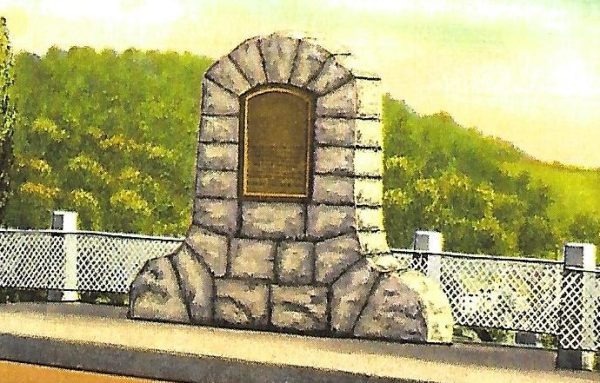
The Original Monument
The McColloch’s Leap monument was placed at 122 National Road near the crest of Wheeling Hill in 1917 by the West Virginia Chapter, Daughters of the Revolution of 1775 (DOR). The installation commemorated the 140th anniversary year of Major McColloch’s daring escape.
The DOR was organized in 1890 with similar membership requirements and goals as the National Society, Daughters of the American Revolution (DAR). The DOR disbanded in 1983. With its demise no organization took responsibility for the monument’s maintenance or accessibility to people wishing to visit it. The City of Wheeling became the monument’s default owner.
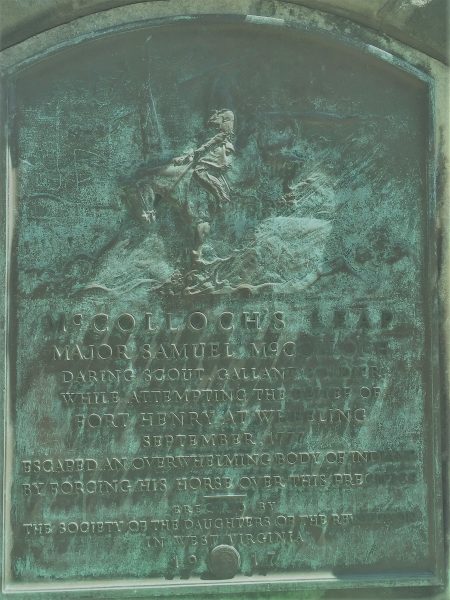
The Bronze Tablet
Set in the original limestone monument was a bronze tablet featuring a bas relief image of Major McColloch descending the steep hillside on horseback, and an inscription:
McCOLLOCH’S LEAP Major Samuel McColloch, Daring Scout, Gallant Soldier While Attempting the Relief of Fort Henry, Wheeling September 1777 Escaped an Overwhelming Body of Indians By Forcing His Horse over this Precipice The Society of the Daughters of the Revolution in West Virginia, 1917
Subscribe to Weelunk
Restoration and Relocation
Inspection of the monument revealed cracks in the limestone stones, and gaps in the mortar between them. The bronze tablet needed cleaning and weatherproofing. It appears likely that there had been little if any maintenance to the monument in over a century.
Since the monument’s 1917 installation, the National Road has been widened to accommodate larger vehicles, especially commercial carriers that used the highway prior to completion of Interstate 70 in 1966. The widened roadway eliminated parking for passing motorists wishing to visit the monument. Portions of the eastbound and westbound sidewalks, which afforded pedestrian access, have been closed due to their deteriorated condition. The City of Wheeling and West Virginia Department of Highways are scheduled to construct a new sidewalk on the north side of the roadway, creating a direct pedestrian path to the monument’s new location.
Community Support and Recognition
In his remarks at the dedication chapter president Jay Frey acknowledged generous support from over 70 donors. Among the most significant contributors are the City of Wheeling, Ray and Dina Carney, the Elizabeth Stifel Kline Foundation, Rotary Club of Wheeling and the SAR’s George Washington Endowment. The Carneys were presented with the Silver Citizenship Medal from the West Virginia Society in recognition of their gift of the property for the monument’s new location. Frey also commended Savage Construction Co. for donating the flag pole and Top Notch Landscaping for covering the labor cost for landscaping the site. The names of donors at the $1,000 level and above are incised on the reverse of the new monument. The total cost of the project was $92,656.
To close the event, a musket salute was given by color guardsmen Larry Perkins (Ebenezer Zane Chapter, OHSSAR), Gary Timmons and Ron Malmgren (George Washington Chapter, PASSAR).
At the 131st SAR Congress last July, the Fort Henry Chapter received one of four national awards given by the National Society in recognition of the McColloch’s Leap restoration.
This spring a new WV historic highway marker will be installed for McColloch’s Leap on Wheeling Hill.
Historical Notes
2024 marked the 250th anniversary of Fort Henry’s construction in 1774. Ebenezer Zane and John Caldwell initiated the project in anticipation of reprisal raids after the murder of Mingo leader Logan’s sister and brother at Yellow Creek—near what is now the Mountaineer Casino Resort on the Ohio River north of New Cumberland, West Virginia. Militia under Captain William Crawford and Colonel Angus McDonald from Fort Dunmore (formerly Fort Duquesne in Pittsburgh) completed the fort with approval from Virginia’s royal governor, Lord Dunmore. The fort was first named Fort Fincastle after Dunmore’s title of Viscount Fincastle, but during the Revolutionary War, it was renamed for his successor, Patrick Henry, following Dunmore’s departure from Virginia.
In 1782 Major Samuel McColloch and his brother John were searching for a Native scouting party rumored to be in the area at Short Creek. When they encountered them, Major McColloch was shot off his horse, mortally wounded. His brother escaped to Van Metre’s Fort and returned later with others to retrieve the remains. It was said that McColloch’s heart was eaten by those who killed him, believing that through this act they would gain his courage.
Sources
West Virginia Historical Society, Vol. XVIII, No. 4, October 2004, The Death of Major Samuel McColloch: Historical Record and Oral History, Robert D. Bonar
History of the Upper Ohio Valley, 1890, Madison, WI, Brant & Fuller, pp. 69-70
History of the Panhandle, 1879, Wheeling, WV, J.A. Caldwell, pp. 103-104
Jay Frey, president, Fort Henry Chapter, WVSSAR


